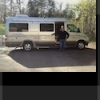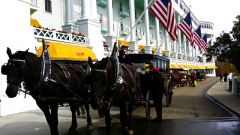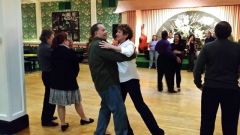-
Content Count
669 -
Joined
-
Last visited
-
Days Won
17
Content Type
Profiles
Forums
Blogs
Gallery
Everything posted by Roadtrekingmike
-

Adjusting the Cabinet Latches and Hinges on a Roadtrek
Roadtrekingmike posted a blog entry in Roadtreking Blog
One of the most discussed how-to threads on the blog and our Facebook Group has to do with the latches and hinges used on the cabinets on new Roadtrek Sprinter models like the RS Adventurous, the eTrek and the CS Adventurous. The same push button latches are on some of the recent Chevy-based models like the 40th Anniversary Special. They are sold by a Montreal-based speciality hardware import firm called Richelieu. The issue is, depending on a lot of load and environmental factors, the latches and the cabinets can get stuck and, too often, as owners try to get them open, they pull too hard the wrong way and break the mechanism. Been there done that. Several times. While I was recently visiting the Roadtrek factory in Kitchener, I ran into my friend and Roadtreking Reporter Campskunk, who also happened to be at the factory that day. We got to talking, the subject of hinges came out and so we marched out to the parking lot and my eTrek to do the above video. If you have a different hinge and locking mechanism, the same general principles should apply, though, obviously, what you adjust and where it is may be different than it was on my eTrek. But the thing to remember is the locking mechanisms and hinges do need to be adjusted from time to time because of the load you put on the cabinet, humidity and the way the vehicle is parked, such as on an angle. Adjusting them is a pretty simple procedure, as you can see, easily done with a small Phillips head screwdriver. The adjust point if on the door to cabinet attachment hinge. The screw you turn is the one closest to the door. You can see the door rise or lower depending on the direction you turn. Also, to keep those latches from breaking, don’t just yank or force those stuck cabinets open. As you see in the video, we just did some gentle pushing from the bottom to get one of my stuck cabinets open. Hope this little video helps. -
Yesterday it was bad pet breath, today, readers want to know how we remove pet hair from our RV. Jennifer and I share how we clean p after our Norwegian Elkhound, Tai. It's not rocket science. The Halo Leather seats of our eTrek help. We throw a cover over them, then shake the hair out each day. As for the throw runs and the rest of the interior of the Roadtrek eTrek we travel in, Jen uses a collapsible broom, an old fashioned whisk brook and sometimes, good old duct tape. One thing we purchased that we are not happy with is the portable “Dustbuster” vacuum. We’ve tried a couple models and found they don’t hold a charge and really don’t do a very good job. We’ve found the best tool is prevention. We brush Tai during walks. Daily brushing outside makes for much less inside shedding. How about you? Use comments below to share how you clean up after your pet.
-

Solving the Problem of Bad Doggie Breath in the RV
Roadtrekingmike posted a blog entry in Roadtreking Blog
We love to take our Norwegian Elkhound, Tai, with us when we go Roadtreking. Except for one thing. His breath. It stinks. Literally. In the confined space of an RV, dog breath can get pretty disgusting. We’ve tried chicken-flavored dog toothpaste and brushing his teeth. It works a little. But chicken flavored dog breath is almost as bad as regular dog breath. So it was with great interest that we just discovered something called Orapup – a dog breath brush. It comes with a couple bottles of Lickies, a liquid that you squeeze onto the soft bristles of the brush. Then you take the brush to your pup and, they love it, liking it all off. It has some natural enzyme that gets rid of bad dog breath and is also supposed to help prevent plaque. My granddauhters Hua Hua and Rachel were over when we put it to the test. Tai loved the stuff. After he licked the brush clean, the girls did a doggie breath test. Their verdict: It works. Jennifer checked, too. She says life with Tai in the RV will be better after he licks that brush. We’ll be taking it with us on future trips with the dog. Rachel, meanwhile, pointed out to me that the company also has a tongue brush meant for humans. She suggested I might want to try it to help with my “Grandpa breath.” Hmmm. -
I came across this interesting You Tube video from a guy who calls himself “Master Luke.” It shows a 24-foot cargo trailer that he made into a totally solar-powered RV. The entire roof of the trailer is covered with solar panels - 3,130 watts worth of them. The Roadtrek eTrek we drive has a 5,000-watt inverter, a diesel generator and about 250 watts of solar power. But I reckon that we can get more practical RVing use out of our rig than he can with his. That diesel generator charges those batteries very fast and the 250-watt solar panels really help keep the batteries topped off. I suppose if stuck in the woods and the diesel tank runs dry, we’d be pretty limited after a few days but don’t see that as a very likely situation we would be encountering anytime soon. But, the installation in this video is very impressive and I think it shows how solar is getting more and more viable for many. I think of applying what he has done in this video to a cabin out in the middle of the Michigan Upper Peninsula woods. And being off-grid is, well, just very cool. What are your thoughts on this setup? Here’s a second more in depth video he did on micro inverters, which he briefly shows in the above video.
-

A Crock-Pot Cooker for Our RV: Recipes Wanted!
Roadtrekingmike posted a blog entry in Roadtreking Blog
It’s hard to believe how much a $16 purchase at Walmart can brighten your day. Such it was the other day when we spotted a pile of Crock-Pots on sale. It was exactly what we needed. Small, round and just the right size to fit in the sink of our Roadtrek eTrek RV. The sink? Exactly. That way, as we travel across the country during the day, the slow cooking crock pot can prepare our evening meals. By the time we reach our destination, a hot, sumptuous dinner is ready. Let’s face it, one of the bothers of traveling in an RV can be meal preparation. After a long day on the road, it’s just too easy to stop for fast food or hit a restaurant. With our new Crock-Pot, we can have a nutritious, home-cooked meal without the hassle. We’ve searched far and wide for the round four-quart sized model for months. We even brought home a bunch of other models that we found. None fit that sink. We had all but given up the hunt until, walking down an aisle at our local Walmart this past weekend, there it was. Boxes of them. exactly what we were looking for. Exactly what we had given up finding. The four quart size is perfect for two people. We can easily get two meals out of each dinner. One to eat that night, one for the refrigerator or freezer. The model we have – for those of you who want one – is officially known as the Crock-Pot SCR4oo-B 4 Quart manual slow cooker. We also found it on Amazon for $15.92 in black. The one we got at WalMart was red. It has a removable stoneware insert for cooking and it also doubles as a serving dish. Ah … but what do we eat, other than beef stew? That’s the reason for this post … we want your recipes. Many of you have been using Crock-Pots for years as you’ve traveled. We’ve read your posts here and on our Facebook Group. So, using comments below, please tell us what you cook in your Crock-Pots and share the recipe. Jennifer and I look forward to trying out your suggestions! -
It sits out there in the driveway with the season’s first snow flurries dusting its windshield as the last of the leaves fall from the trees. Inside the RV, there’s the faint but sweet smell of the antifreeze I ran through the plumbing last week. The doors to the refrigerator and the freezer are open to air out. The food and coffee in the storage cupboards are emptied. Only a Roadtreking sweatshirt and a Family Motorcoach Association nylon jacket hang in the once crowded wardrobe. My wide brimmed hat with the pins and buttons collected from national parks and scenic attractions hangs by its neckstring behind the driver’s seat, waiting, seemingly, to be put on and to begin another trip. You can see your breath when you step inside. Tai, our 10-year-old Norwegian Elkhound who has had the best year of his life seeing the country in the Roadtrek, guards and patrols it like a treasure. Sometimes he lies down on the driveway, right outside the sliding door. If it’s going anyplace, he seems to be saying, it’s taking him. The Roadtrek eTrek that has carried us across 33,000 miles of North America over the last 12 months is ready for the cold Michigan winter. It would shiver if it could. Inside our sticks and bricks house is a calendar now filled with planned trips for the coming year. But first comes the slowest travel time of the year, the weeks leading up to Thanksgiving and then Christmas. So right now, it sits parked and – am I imagining this?- looking lonesome and forlorn. Do RVs dream? Silly question, I know. But we do imbue them with personalities, naming them, referring to them by gender specific pronouns. We look at them and think of the places we’ve been, the places we will visit. They represent freedom, adventure, the excitement of pulling out and the call of the open road. They sure make us dream, don’t they? Soon, loyal eTrek ... soon.
-
I know we’ve talked a lot about winterizing over the past few weeks. But here’s one more report, this one documenting my do-it-yourself winterizing of my Roadtrek eTrek. For the past two years, I’ve paid over $100 to have it winterized by RV service dealers. From the blog and our Facebook page, readers have told me that it’s no big deal and it it is something that even an unhandy handyman like me can do. So this year, I decided to see take their advice and do my own winterizing. I’ve read all the various suggestions and methods of winterizing an RV and, especially, winterizing a Roadtrek motorhome. I’ve talked to three big service centers at Roadtrek dealerships and I’ve studied the “official” suggestions of Roadtrek. Based on those discussions and the suggestions I received, this is my DIY approach: It started with a firm decision NOT to put antifreeze in the fresh water tank. Some people do. The dealerships I consulted urged me not to do that for the simple reason that getting rid of that sickly sweet antifreeze taste come time to unwinterize in the spring is very difficult to do. Needless to say, I throughly drained my fresh water tank, even driving around with the drain valve opened on the trip home from my last outing. That, all three service shops insisted, was all I needed to do for the fresh water tank. My winterizing approach involved two special tools: 1) The Camco 36153 RV Brass Blow Out Plug, available for just over $5 from Amazon or a bit more at my local RV dealer. This little plug screws into the city water hookup. I need to point out although all three Roadtrek dealers I consulted DO use compressed air, under 40 psi, to blow out the line, Roadtrek itself does NOT recommend forcing compressed air back through the lines. But I do see the wisdom of pushing what water may be in the lines back to through the faucets so I attached a bicycle pump. It did indeed push some water out the faucets and down the drain so I feel good about that, knowing I did not run air at high pressure and, as Roadtrek warns with compressed air, run the risk of damaging the plumbing. 2) The Camco 36543 RV Pump Converter Winterizing Kit. This is a little valve that attaches at the water pump and allows you to siphon water directly from a bottle of antifreeze into the RV pipes and out the faucets, thereby protecting pipes and connections. This is very clean and neat and makes winterizing so easy, especially if, as I plan, I will probably have to winterize several times this season as I drive to warm climates and then return to the cold north. Cost is $12.65 through Amazon. I did the above video to show how it all works. Total time was bout 20 minutes, and that was with me doing the video as I went through each stage. I used just under three gallons of antifreeze, making sure it ran through all the faucets, flushed through the toilet and also flowed through the cold and hot water filters and my outdoor shower. I also removed the water filter, which will be replaced by a fresh one in the spring. After that, I put about a cup down each trap. I once again dumped the black and grey water tanks, running the macerator and making sure pink stuff came out. Finished with that, I dumped a half gallon of antifreeze down the black and grey tanks. These general steps will work with just about any RV. My eTrek has a special Webosto water heater and I followed Roadtrek’s suggestion to drain the tank of water. That’s pretty much all it needs. Your heater is probably much different and you should consult your instruction manual for specifics. Now I’m ready for cold weather. Jennifer and I will still use the eTrek during the cold months. We just won’t run water through the pipes in cold weather. We will use antifreeze to flush the toilet. But as the temperature drops, the eTrek is now ready for Old Man Winter. Bring it on. The blow out plug for the city water connection The winterizing kit for the water pump The winterizing kit siphons antifreeze directly into the RV plumbing system.
-

How We Roll in Our RV: Air Conditioning and Unattended Pets
Roadtrekingmike posted a blog entry in Roadtreking Blog
It can heat up very fast inside an RV and in this edition of How We Roll in our RV, Jennifer and I answer a question from a reader named Danielle who asks: “I’m thinking about taking my freelance writing business on the road in a small motorhome, and I have a question. I’ll be bringing my dog with me and I’m concerned about leaving her in the RV while running errands. Can a dog overheat in a motorhome as they can in a car? Can the A/C run off the battery while sitting in a parking lot, or would I have to run the generator and risk the wrath of quiet townsfolk? Any advice from you (or Tai!) would be much appreciated. Thanks, and safe travels!” Jennifer and I take our Norwegian Elkhound, Tai, with us and since he has a double coat and doesn’t tolerate heat well, we worry about leaving him unattended for long periods of time, even with the AC on and even in our Roadtrek eTrek, which can run the AC on battery power for long periods of time. We don’t leave him unattended even when we are plugged into shore power at a campground. Indeed, many campgrounds have rules about that. How many times have you walked by someone’s RV, only to hear some yipper inside loudly sounding his concern about being abandoned. It is rude to other campers and not very nice to your pet to leave a barking dog alone. Our Tai is not a barker, he’s a sleeper. But what if the AC in the park went out? Like a car, an RV can heat up very fast. So we pretty much always take him with us, except for short periods of times like when we are eating in a restaurant. And then only if we run the AC in warm weather and check on him frequently. You can click the video to hear our response to Daniele’s question. And use comments to offer your suggestions. Meantime, if you have a question about How We Roll in our RV, send it to us at openmike@fmca.com -
One of the biggest challenges for couples and families these days is staying connected…and keeping busy and often confusing schedules coordinated. When you throw in an RV and lots of traveling, life can really get complicated. That’s where smartphone technology can really help. I have some great apps I juts shared with my NBC-TV audience this week that will help you stay in touch with your spouse and other family members and bring some organization to those busy schedules. One of the handiest apps I’ve found for couples is Twyxt. This app started out as a lovey-dovey, touchy-feely app to send sweet nothings to each other during the day. But it now has so many added features that it is downright useable. It shares calendars and to-do lists and photos, memos and notes and even a private messaging system as well. If one person updates, the other person’s Twyzt screen is also updated. It’s free, for the iPhone and Android devices. Android and iPhone users looking to stay connected to family members will want to try the Life 360 app. It bills itself as a Family Locator App… and more. It shows on a map where other family members are at any given time. This is great for RVers. You can connect with each other by private text messaging and keep other family members up to date on your plans or share your schedule. iPhone, iPad and Android users will appreciate the Cozi Family Organizer. It sets up and shares a family calendar, sends out reminders, has a family shopping list, a to-do list and even a family journal. It’s very easy to work…and it’s free. So there you go.
-
I didn’t think I’d make it down the narrow, twisting and very bumpy forest two-track that led to my current camping spot in the middle of a marsh on the edge of Rush Lake, a compact little frown-shaped lake a mile or so south of Lake Huron at the tip of the Michigan thumb. I’m surrounded by state land and cattails, a half dozen yards from where my buddy Jay launched our duck boat. Jay and I have been coming up here to hunt ducks and geese for years. Usually, we stay in a motel in Caseville, the nearest town to the west. Jay, in fact, in in a room there now as I write this. I offered him a bunk with me in the Roadtrek but he declined. He likes the marsh, just not sleeping in it. Go figure. But I’m in the marsh, and I like sleeping in it just fine in my Roadtrek eTrek. All the comforts of home in the middle of nowhere. It’s the first time I’ve camped here and, for a while, I didn’t think the Roadtrek would be able to get to this spot because of the so called road that dead ends here. I had to drive very slow and hug the edges of the road. No Class C could do it. And certainly no Class A RV. But the eTrek did and as I write this post, I’m surrounded by a darkness that, unless you’ve spent time in a big marsh after sundown, you won’t fully be able to appreciate. Trust me when I say it is really, really dark out there. Rain is coming. Perhaps overnight but predicted for sure by mid-morning. By then, we’ll have motored across the lake to our duck blind, where we’ll be trying to stay dry. But during our afternoon hunt yesterday, it was just overcast. We saw hundreds of ducks and lots of geese. We didn’t fire a shot. And that’s okay. I now shoot more photos than ducks. Jay cleans, cooks and eats what we shoot. I don’t like to eat wild duck, ever since I nearly cracked a tooth on a shotgun pellet a few years back. I come duck hunting because, well, I like watching the sun rise in a marsh. And set, too. And in between, I love to watch the cattails blow in the breeze, the muskrat ripple the water in long slow wakes, the waterfowl whirl and twirl as they set their wings to land in our decoys. One year, we watched a deer swim across the lake, emerging just a few dozen yards from our blind. And when it rains and the wind blows, the ducks fly. So the predicted downpour may be uncomfortable for us. But its just ducky for the ducks. When we return home from our duck hunting trips, Jennifer always asks”what did you and Jay talk about?” I always answer the same. “Nothing.” She always shakes her head. “How can two people sit shoulder to shoulder in a duck blind all day long and not talk about anything?” I don’t know. One time, Jay and I did talk about that. He told me his wife, Julie, asks him the same question. We were both puzzled by what they wanted to know. We don’t “talk.” We hunt together. I watch one way, he watches the other. “Two o’clock,” I’ll say. “A small flock of mallards headed our way.” Jay will offer a left-handed version of that when appropriate. “Teal. Three o’clock,” he’ll say. If we do shoot, we might say “nice shot,”when a duck falls, or “missed that one” when I fire but the duck doesn’t fall. I confess: That kind of talk of gets on my nerves. I mean, I know I missed. But the point is, we just enjoy the outdoors and each others company. Last night, after we went into town for dinner, Jay dropped me back at the Roadtrek in the marsh. As I write, I have the Webosto heater cranked on. I have a strong 4G Verizon signal and am running my own Wi-Fi network as I updating this blog and answer questions on the forum. I was going to watch a movie on the DVD. But I decided instead to go to bed early as we’re planning to be back in the blind by first light. I love being totally self-contained like this, with plenty of power, plenty of heat and… in the middle of a very dark marsh where the only home is my motorhome. Boondocking here in my Roadtrek has made this year’s duck hunting trip even more fun. Hey, maybe I’ll talk about that with Jay in the duck blind. Here are some more photos: On the shore of Rush Lake Lots of ducks were flying. I have the place to myself. Jay at the motor as we head to the blind In the duck blind Sunset in the marsh
-
One of the most asked questions Jennifer and I receive from readers deals with how we sleep in our Roadtrek eTrek Class B motorthome. Our answer is … great! Seriously, we both agree we sleep better in the Roadtrek than we do in our king-sized Sleep Number bed at home. And that has to do with that we sleep on and in while camping out in the Roadtrek. In this edition of How We Roll in our RV, we answer two reader questions about where we store our bedding. We make the eTrek sofa up into a king sized bed at night and use a four inch Wamsutta Fresh and Cool mattress topper that we picked up last year at a Bed Bath & Beyond store while traveling through South Dakota. Jennifer shows how we store in in the overhead cabinet at the rear of the bed. It takes up every inch of space up there but it fits in just fine. On top of the topper, we use an RV Superbag. It’s a king sized bag with a summer and winter side and very comfortable sheets Velcroed inside. I show how we roll it up and put in in the armoire that we have installed in place of the seat that normally is behind the driver. Here’s a link to the RV Superbag video review Jennifer did last year. Yes, I know those bags are expensive. But we really like it, so much that we also invested in two individual RV Superbags. I use a single when I travel alone or bring a grandkid or buddy with me on a hunting or fishing trip. Got a questions you’d like us to answer? Send an e-mail to openmike@fmca.com.
-
Jennifer and I went to the local office supply store over the weekend and picked up a new planning calendar for 2014. It’s one of those big, poster-sized ones with the entire year laid out in neat little blocks for each day of each month. It’s erasable – a good thing with our propensity for last minute trips and change of plans – and right now, it’s blank. But we’re about to start filling it in. We’ve gone through and listed all the places we want to go, the things we want to see, the people we want to meet and if we to start entering them all on our new calendar, there would be no space left. We need to do some culling. But, so far, here’s what we’re pretty agreed upon for our RV travel goals over the next year: Next trip is Tuesday when I’ll head up to the top of the Michigan Thumb and spend a couple night parked in the middle of a marsh doing somd duck hunting with a friend. Then, Dec.3-5, we’ll head to the Recreation Vehicle Industry Association annual trade show in Louisville. This is an industry only show, not open to the public. We had planned to attend it last year but it just didn’t work out. I was recuperating from a knee replacement and all that walking would have been tough. But this year, with my bionic knee, I’m more than ready. Come the new year, we’re planning a winter camping trip. Maybe Tahquamenon Falls in Michigan’s Upper Peninsula, where the state DNR plows and keeps open about a dozen spots. We stayed there last year with 28 inches of snow on the ground and had a ball. Come the 25fth of January, we’re tentatively penciling in a trip to northern Minnesota to follow the mushers on the historic and legendary 400-mile long John Beargrease Sled Dog Marathon. Our Roadtrek is equipped with amateur radio two-way communications and we’ve been asked to volunteer our Roadtrek and radio gear to help with communications in the northwoods wilderness out where the cell phone signals disappear. In February, we’re looking to hit the Gulf Coast, follow it to Gautier, MS and something called “Smokin’ on the Bayou,” being organized by our Facebook Roadtreking Group buddy Paul “Pogo” Konowalchuk. After that event ends, we’ll keep moving west to the Texas Hill Country and then Arizona to chase down several stories sent in by readers. March 17-20, it will be the Family Motor Coach Association’s Family Reunion and Motorhome Showcase in Perry, Ga. Those are the trips planned over the next four months. Then comes spring and summer where we want to visit Yellowstone, as we do every year, and then Glacier National Park. That far west, it would be nice to go all the way to the Oregon coast to see what our pal Campsjunk has been raving about. Either late June or early September, we also want to do a big trip north and east to the Canadian maritimes. The Albuquerque International Balloon Fiesta in New Mexico also has us intrigued for early October 5-13. So many places. We have several different colors of erasable ink to use on that big new wall planner. We’ll list RV shows, unique festivals and special events that sound interesting in orange. Our must-attends will be in black. The potential trips not yet cemented down will be entered in red. And short weekend getaways that we can plan out will be in blue. Added to that will be special family events and holidays will be green. And we’ll keep the eraser handy. This past year, we have put 33,000 miles on the Roadtrek eTrek. Next year looks like it may even be more.
-
We’ve been talking all week about winterizing our RVs. Yes, the time has come .... Those living in the northern states and those who live where the temperatures drop below freezing, can’t put it off much longer. But people still have a lot of questions and as we wrap up our winterizing series, Jennifer and I answer some reader questions about topics that haven’t yet been addressed. In this edition of How We Roll in our RV, we talk about the need to re-winterize when folks head south and then back north. And we answer a reader question about whether the flat-screen TV needs to be removed when the unit is exposed to the cold for prolonged periods of time. Oh yeah, we also sound a very important warning for those of you who put your RV in storage for the winter. Check out the above video and send your questions in to us at openmike@fmca.com. Your’s just might be the next one we answer in our next How We Roll episode.
-
No matter what kind of RV we have, one thing that we are all interested in is the weather. Nothing affects traveling more. Across North America, the cold weather is coming fast and that means snow and ice and dicey weather conditions. Thanks to apps, tablets and the Web, you never again need to wonder what its going to be like out there. I’m always installing and uninstalling weather apps. I’ve tried dozens of them and I’m sure I’ll try dozens more in the months ahead. But for now, here’s a roundup of my favorite weather apps. When bad weather threatens we want to know when and where it will start. And that’s where the new Forecast.io website comes in. It accesses the radar data available from the U.S. government, crunches and analyzes it all and then predicts rainfall and snow for your exact area by the hour and lays it out on a very elegant website. You can get global, regional and local views with just a mouseclick. The tools that the website uses to compile the reports and predictions then are spun off into two apps for smartphones and tablets, one for the Apple platform, the other for Andoid devices. They, too are, pretty slick. The iPhone app is called Dark Sky. It costs $3.99. The Andoid app is Arcus Weather. Its free right now, though they ask for a donation. Here are some other weather apps I use: When we’re setting out on an RV trip, I really like the Road Trip Weather App for the iPhone. It costs $1.99 but is very handy. It provides a personalized weather forecast for your drive based on WHERE you will be and WHEN you will be there. Enter your route & departure time and weather data populates on the map, showing potentially hazardous conditions. If you want to know everything there is to know about the weather, WeatherBug is the what you want. When you launch the app, it immediately displays current local weather, including temperature, dew point, humidity, sunrise, sunset, wind, pressure and any active weather alerts for the area. This is good as you are traveling as it always updates your current weather. A toolbar along the top lets you switch from the current forecast to a more detailed forecast, hourly forecast, or 7-day forecast. A toolbar along the bottom lets you access weather radar, live webcams in your area, lightning strike information and the pollen count. The WeatherBug app has a great radar link but sometimes we want just radar and as much of it as we can get. For Android users, I like RadarNow!. It gives directly to instant radar from your current position. For the iPad and iPhone, try the MyRadar app. There are no shortage of weather apps. Those are my favorites.
-

Taxes and Fees for RVs Can Be Very Confusing
Roadtrekingmike posted a blog entry in Roadtreking Blog
One of the most confusing aspects of buying an RV is the vast differences paid in sales tax and various licensing fees. And many states do what is called “double dipping,” charging full sales tax when you buy the vehicle, and then again charging you tax on the full purchase price of a new one when you you trade it in, ignoring the trade-in price. It doesn’t take a genius to know that it is patently unfair. In Michigan at least, that double dip tax is about to go away. State lawmakers are getting ready to send a big change in vehicle taxes to Governor Rick Snyder’s desk. The bills would cut the amount of sales tax people pay on cars, boats and recreational vehicles when they trade in another. Right now, the full purchase price is taxed. The legislation would gradually change that to eliminate the value of the trade-in from the full purchase price for taxes. But the taxing differences and inequities still abound, state-to-state. Montana, for example, is a state with no sales tax. And Montana law allows for a Montana corporation to register vehicles in the state. Thus, a whole cottage industry has built up that allows RV owners to avoid sales and use tax and often stiff registration fees in the owner’s home state. Thousands of RV owners around the country do this and dozens of Montana legal firms specialize in making it happen. Some states have sales taxes, others don’t. So what if you live in a state that does have an RV sales tax, but buy in one that doesn’t? That’s called a cross-state sale. And each state has different rules about cross-state sales. Sales on the trade-in differences also vary from place to place. Some states charge on the difference between the trade-in value and the original purchase price. Some on the full trade-in. But what if you full-time? At least a million RVers do full-time. But for taxation purposes, everyone has to have a legal domicile. But where? Many RVers choose a state with no income taxes and low taxes and fees on licensing and registration like South Dakota. Alas, that state has recently stated scrutinizing those who are RV full-timers – they call them “nomads” – but the process is still available. Here’s a site with some detailed info. All this is to say that given the cost of today’s RVs and the wide discrepancies on taxation and licensing fees, there’s a lot to consider when investing in an RV and the RV lifestyle. I’d love to hear how you have handled the domicile, tax and fee issues in your RVing life. Use comments below. -

The RVer's Biggest Danger: Carbon Monoxide Poisoning
Roadtrekingmike posted a blog entry in Roadtreking Blog
It has happened again. This time in Alabama at a campground near the Talladega Speedway. Craig Franklin Morgan, 46, of Murfreesboro, Tenn., died from carbon monoxide poisoning. Morgan and his wife, Jami Allison Morgan, 38, were discovered unresponsive by friends who went into their RV at the South Campground outside the track. Jami Morgan was unconscious and was airlifted to a nearby Hospital, where she remained in critical condition and unconscious Monday morning. Police said the carbon monoxide apparently leaked from the exhaust system of the family’s RV. Talladega County Sheriff Jimmy Kilgore told myfoxal.com that the couple’s RV had a broken exhaust pipe on its generator, which ran all night Friday. When the Morgans didn’t come out Saturday morning, friends went looking for them. Carbon Monoxide is an invisible, odorless, and deadly gas, produced by the partial combustion of solid, liquid and gaseous fuels. Carbon monoxide is the number one cause of poisoning deaths each year. Almost all of today’s RVs come with carbon monoxide monitors. But they can, and do malfunction. Thus, as a matter of routine, you should test the carbon monoxide detector every time you use the RV If they have batteries, replace them at least once a year, twice if the unit is exposed to extreme cold. A good tip is to change the batteries when when you change clocks for daylight savings time. The sad thing is that many deaths occur when the victim is asleep. If their detection monitor is not working, or if they don’t have one, they just stop breathing. There are symptoms that are noticeable when awake. They are similar to the flu, but without a fever. They also may include. Dizziness Vomiting Nausea Muscular twitching Intense headache Throbbing in the temples Weakness and sleepiness Inability to think coherently Here is some more advice specific to RVs, as suggested by the website Carbon Monoxide Kills: Inspect your RV’s chassis and generator exhaust system regularly, at least before each outing and after bottoming out or any other incident that could cause damage. Inspect the RV for openings in the floor or sidewalls. If you locate a hole, seal it with a silicone adhesive or have it repaired before using your generator again. Inspect windows, door seals, and weather strips to ensure that they are sealing properly. Yellow flames in propane-burning appliances such as coach heaters, stoves, ovens, and water heaters usually indicate a lack of oxygen. Determine the cause of this condition and correct it immediately. If applicable, have your built-in vacuum cleaner checked to make sure it does not exhaust under the underside of your RV. Have the system changed if it does. Do not operate your generator if the exhaust system is damaged in any way or if an unusual noise is present. Park your RV so that the exhaust may easily dissipate away from the vehicle. Do not park next to high grass or weeds, snowbanks, buildings, or other obstructions that might prevent exhaust gases from dissipating as they should. Keep in mind that shifting winds may cause exhaust to blow away from the coach one moment and under the coach the next. When stopping for long periods of time, be aware of other vehicles around you, such as tractor-trailers at rest stops, that may have their engines and refrigerators running. Do not sleep with the generator operating. Leave a roof vent open anytime the generator is running, even during the winter. If you do not feel well, do not be fooled into thinking that it is because you have been driving too long, you ate too much, or you are suffering from motion sickness. Shut off the generator and step outside for some fresh air just to be sure. -
From the album: Dancing the Weekend Away on Mackinac Island: Where your RV C
A full orchestra provided the music for the dancers. -

Dancing the Weekend Away on Mackinac Island: Where your RV C
Roadtrekingmike added images to a gallery album in Members Gallery
-
From the album: Dancing the Weekend Away on Mackinac Island: Where your RV C
The Roadtrek at the ferry dock ... as far as it could go this weekend as we headed to Mackinac island. -
From the album: Dancing the Weekend Away on Mackinac Island: Where your RV C
From the porch of the Grand Hotel -
From the album: Dancing the Weekend Away on Mackinac Island: Where your RV C
East Coast Swing -
From the album: Dancing the Weekend Away on Mackinac Island: Where your RV C
The tourists are gone as the island waits to shut down next week. There are still a couple of fudge shops open, though. -
From the album: Dancing the Weekend Away on Mackinac Island: Where your RV C
The fort on Mackinac Island has been around since the American Revolution. -
From the album: Dancing the Weekend Away on Mackinac Island: Where your RV C
The Victorian summer homes on the west bluff -
From the album: Dancing the Weekend Away on Mackinac Island: Where your RV C
The Grand Hotel at night© T












